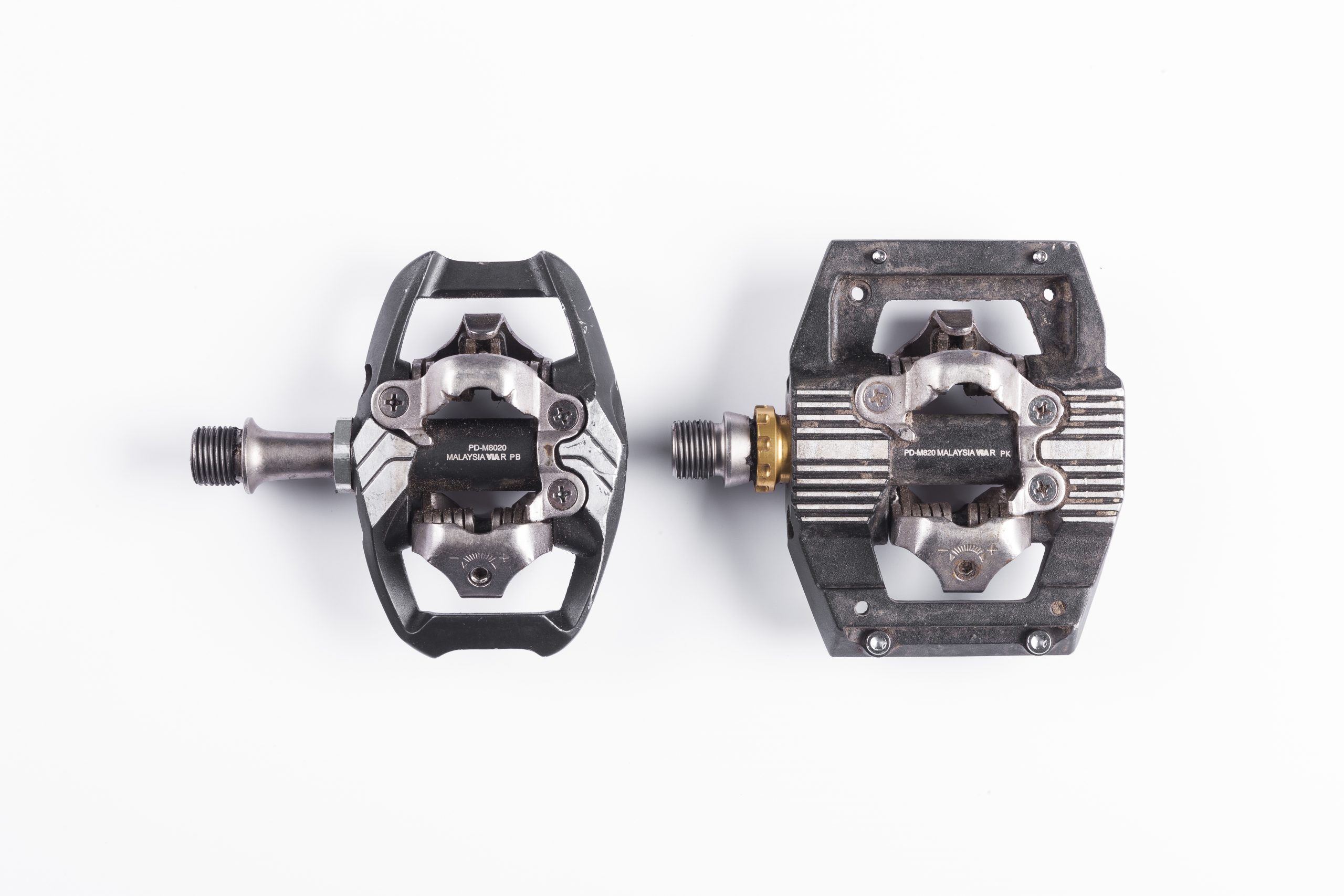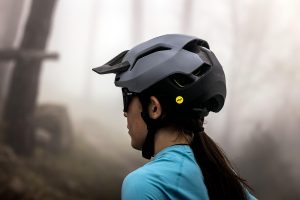Quite simply the best clipless (or clip-in) mountain bike pedals on the market today, plus what to look out for in the latest big-platform pedals
Clipless pedals are brilliant at delivering power and control through your feet, so it’s no wonder they’re the prefered choice for racers the world over. That means there are clipless pedals for all disciplines, and I’ve cherry picked the best half dozen in this buyer’s guide… no mean feat given we’ve tested hundreds of them.
Here you’ll find the best caged pedals here for e-bikes, enduro, gravity racing, and trail riding, as well as a more traditional cageless option from Shimano. Just remember to think about the other half of the pedalling equation too, how your shoe will fit with the pedal – if you’re lost check out the best mountain bike shoes. Or, if you fancy a more playful ride experience, check out our buyer’s guide to the best mountain bike flat pedals.

The Mallet DH has been our favourite pedal since 2018, and its support and control is still unmatched
1. Crankbrothers Mallet DH
The best all-round clipless pedal for gravity riding
Weight: 480g | Platform: 100 x 79mm | Rating: 10/10
Reasons to buy:
- Best of both flat pedal feel, and clipless reliability
- Exceptionally reliable engagement, even in terrible conditions
Reasons to avoid:
- There’s no discernible click to let you know when you’re clipped in
- Brass cleats take careful set-up and wear faster than steel versions
The Crankbrothers Mallet DH sounds like a downhillers pedal, but don’t let that put you off – it’s the best pedal hands down for everything from enduro and gravity riding, to trail centre laps. Why? It delivers the perfect balance of grip and control, letting your foot touch the pedal for added grip, but still move around without unclipping for improved feel.
It’s this float that really sets the Mallet DH apart, providing a flat pedal feel with clipless security. Crankbrothers has also added rubbery Traction Pad Technology grommits to increase grip in the mid-section.
Read our full test review of the Crankbrothers Mallet DH pedal

Shimano’s PD-M540 is about as simple as it gets, cageless means it’s lighter and also cheaper… a great XC racer’s choice
2. Shimano PD-M540
Best value XC clipless pedal
Weight: 405g | Rating: 9/10
Reasons to buy:
- Does everything it needs to at a great price
- Lightweight and thoroughly reliable
Reasons to avoid:
- Lacks style points and foot stability over the latest platform pedals
The Shimano PD-M540 pedal is a true classic, and our testers have been using the same samples for nearly 20 years now without any problems thanks to the superb bearing quality and the durable materials. If you’re after a no-nonsense pedal at a great price, you’ve found it – it’s easy to clip in and there’s a definite click to let you know when you’re there. The release is just as easy and predictable, with plenty of feel and feedback when you twist out. The tension adjustment works a treat too, with a wide range, from extremely light to almost locked.
Read our full test review of the Shimano PD-540 clipless pedal

The Crankbrothers Mallet E gives more pedal clearance than the Mallet DH, but still offers great feel and security
3. Crankbrothers Mallet E
Best for trail riders and e-bike riders
Weight: 445g | Platform: 80 x 90mm | Rating: 10/10
Reasons to buy:
- Not too hulking, so less chance of catching a pedal than the Mallet DH
- Great in the mud
- Decent foot stability from platform
- Good durability
Reasons to avoid:
- Pricey
- Cleat setup often requires spacers
- Brass cleats wear faster than steel versions
The Mallet E is much like its award winning Mallet DH brother, albeit with a subtle tweak that I’ve found really does make it ideal for e-bike use. The Mallet E comes in two different axle lengths, meaning you can tweak the Q-factor – the distance between your feet – for the optimum fit. This is priceless on e-bikes, where I often find myself pedalling with a bandy-legged gait.
The four bar mechanism is still dead easy to clip into, whichever way your foot arrives there, and the open design means it’s great at shedding mud. I’m less precise riding and e-bike than an analogue, and much more likely to bottom out the pedals into the ground, and that’s where the slimmer body of the Mallet E comes into its own.
Read our full test review of the Crank Brothers Mallet E

Shimano’s Saint SPD pedal is built like a brick outhouse
4. Shimano Saint PD-M821 pedal
Best for durability
Weight: 556g | Platform: 100 x 75mm | Rating: 10/10
Reasons to buy:
- Large platform gives great stability
- Easy to service with no specialist tools required
- Common cleat type, meaning replacements are easy to find and cheap
- Good mud clearance
Reasons to avoid:
- Too heavy for trail or XC use
Shimano’s latest Saint-level SPD is one of the biggest and heaviest clipless pedals on the market, but that meaty cage is pretty invisible when your foot is on it. The speed of engagement and release is comparable to the Crankbrothers Mallet – the only difference is the Saint needs a bit more force to unclip, but that does mean it is a bit more positive. When it comes to platform clipless pedals it’s close call between the Shimano Saint and the Crankbrothers Mallet E. However, the Saints may well be heavy but they are easy to set up, offer impressive performance and are great value.
Read the full review of the Shimano Saint PD-M821 pedal

DMR’s V-Twin is a leftfield alternative that works decently and offers great colour-matching potential
5. DMR V-Twin
Best clipless pedal for custom style and colour
Weight: 553g | Platform: 82 x 100mm | Rating: 8/10
Reasons to buy:
- Excellent pivoting cage design really works well
Reasons to avoid:
- A bit expensive and a bit heavy
Riders of a certain age may remember the classic red Shimano DX caged SPD. Well, Shimano’s patent on the sprung/pivoting external cage expired a few years ago and DMR were quick to pounce on the opportunity to produce its own take on it. When not clipped-in, the internal mechanism stands slightly proud, popping its head out of the platform, which makes it easier to locate when clipping-in. Once found, the cage rotates to lie in the same plane as the mechanism. It’s a great system that we’re surprised more companies don’t use.
In one regard we actually prefer the V-Twin’s indexed tension adjustment system compared to other Shimano cleat-friendly engagement mechanisms which lack indexing. It’s just easier and more reassuring when attempting to get each of the four mechanisms behaving in the same way.
Read our full test review of the DMR V-Twin pedal
How we tested the best mountain bike clipless/clip-in pedals
We tested and evaluated each pedal to find out how well the pedal engages with the sole unit of our test shoes. Sole engagement mustn’t compromise cleat engagement, however, something that is dependent on the thickness of the rubber and the depth of the cleat recess. To provide a fair comparison, every pedal was tested using the same pair of Specialized 2FO Cliplite (EU size 44) shoes. Of equal importance is the platform size; pedaling and cornering testing helped determine the ground clearance and practicality as well as determining how easy the pedal is to locate in a hurry.
What to look for with mountain bike clipless/clip-in pedals:

Grease the bolts beforehand to save getting the drill out later!
Cleats
The cleat is the physical link between pedal and shoe. Normally made of steel or brass alloy, all mountain bike cleats use a two-bolt design to attach them to the shoe. They have special shaping to enable them to engage with the pedal mechanism. Many cleats are based on Shimano’s original SPD design and are cross-compatible. But some brands, such as Crankbrothers, use a specific, unique design. Brass cleats will wear out faster than steel ones.

HT’s X2 pedal has a tension scale so you can ensure all four sides are equalized.
Release tension
This is how much force it takes to release your foot from the mechanism. Most of the pedals on test allow for some form of spring tension adjustment to alter the force needed to clip and unclip. On pedals such as Crankbrothers, with its twin-bar mechanism, tension cannot be adjusted.

Mid-size platforms (left) give a bit of foot support and protect the mechanism while giving loads of ground clearance. Larger platforms (right) add support for better feel and comfort, but at the expense of clearance.
Platform size
The bigger the platform around the clip mechanism, the better the foot support. A larger platform will give you somewhere to rest your foot if unclipped, especially on a technical section of trail. A larger contact patch will also make pedalling more efficient and much more comfortable, especially with softer soled trail shoes.

Two pins at each end offer grip when not clipped in
Grip
Many of the larger, trail-style pedals take inspiration from flat pedals and include adjustable height pins to alter grip. In most cases these need to be finely-tuned to balance traction and the ability to unclip safely.

SPD or flat pedals: they both need a little TLC to keep rolling smoothly
Bearings and sealing
Most pedals use a combination of bearings to keep them spinning smoothly and prevent lateral play. The typical set-up is a combination of one or two cartridge bearings combined with a plastic or ceramic bushing. Sealing is very important due to the location and forces that go through the pedals in order to keep mud and water from penetrating.

Float is determined by the shape of the cleat
Float
All of the pedals here have floating cleats. Float is the free movement you feel when you are clipped into the pedal. For the majority of systems float is a good thing, as it helps to reduce the stresses of being clipped in on your joints and can prevent unwanted release.
















